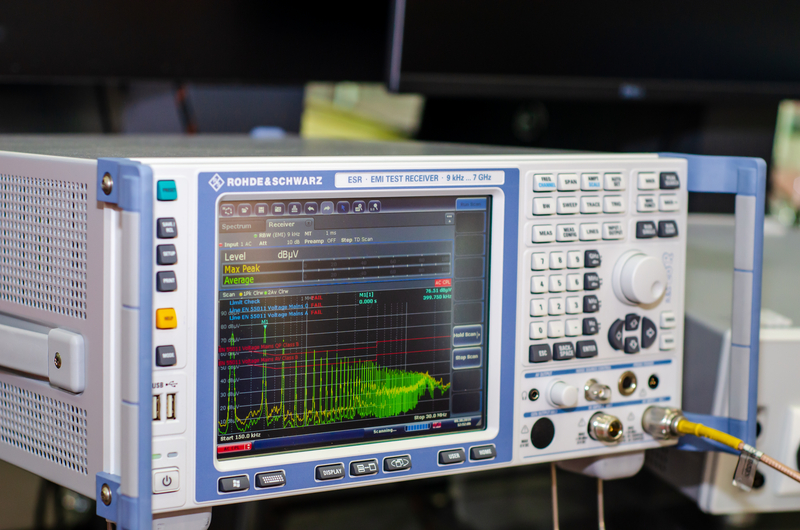
EMI emission test failures for compliance testing are a major cause of product development delays because most products fail in their first trip to the lab. Radiated Emissions is the most common problem for developmental electronic products and one that is often difficult to mitigate. This holds true for both military and commercial products.
Radiated Emission Test Standards
For most commercial equipment radiated emission testing must be performed per CISPR 11/EN 55011, CISPR 32/EN 55032, or FCC Part 15 to achieve certification. Medical , industrial, and scientific equipment are tested to CISPR 11. For equipment designed for U.S. military applications and space system applications MIL-STD-461 is the standard used. These testing requirements vary in terms of frequency range measured, acceptable levels of radiation, and test equipment employed in testing.
Limits imposed on emissions in MIL-STD-461 are severe and well below most commercial standards. There are two separate test procedures for radiated emissions in this standard, RE101 for magnetic field emissions from 20 Hz to 100 kHz and RE102 for electric field emissions.
Testing measurements for RE102 are made with antennae position 1 meter away from the Equipment Under Test and test values are peak values, not average or quasi-peak. Furthermore, this testing can be a requirement for high frequencies up to 18 GHz.
Common Mode Considerations
Electromagnetic energy emanating from electronic devices appear in two modes, common and differential. Common-mode emissions appear simultaneously on two conductors in the same phase. Often these electromagnetic fields will radiate from cables connected to equipment being tested.
This energy will generally not be related to the intended signals on the cable. Because these emissions are in phase different mitigation techniques must be considered than those commonly used with differential signals. For lower current applications common mode chokes can provide required levels of signal reduction.
EMI Emission Design Issues
Application of ferrites and shielding at the lab is often a desperate battle with diminishing returns. The best strategy is to identify major sources of emissions early in the design and mitigate at the source. A well-designed Printed Circuit Board (PCB) can alleviate many problems but it is important to remember that every interconnecting cable is an antenna that can provide a path for radiated emissions.
Unwanted radiated emissions can be mitigated utilizing a number of strategies in the design stage but, each product has its area of special concern. A product that controls stepper motors will have very different mitigation issues than a Bluetooth communication device.
Switching power supplies are a common area of concern for all products. This includes main power sources and Point of Load (POL) circuits. Care must be taken to ensure the selection of components in these circuits (e.g. low ESR capacitors) and their proper placement and interconnection.
Preparation for Emissions Testing
A great design can still fail if poorly constructed. Pre-production or early production samples of products often will have paint and coatings in unwanted areas resulting in ungrounded cables and chassis parts. Cables utilized for testing will often not be representative due to size constraints of the lab.
These cables often are not constructed to the same standards and may not have adequate shielding. Off-chamber simulation and monitoring equipment requires special attention. This equipment can often contribute emissions that will cause a “false” EMI emissions test failure.
CVG Strategy
Our experts at CVG Strategy have extensive experience in EMI/EMC. We can provide pretest analysis to help reduce EMI emission test failures and their resultant delays. We also have expertise in Environmental testing and evaluation in a number of industries and products, both military and commercial.
The fact is that most EMI/EMC tests result in failures. Design teams often have to go through multiple design iterations before achieving success. Our EMI/EMC experts can provide a pretest analysis of a product to identify potential design shortcomings and provide appropriate modifications. This prevents costly program delays and patchwork solutions.
Our EMI/EMC engineers can provide a wide array of services to help you with your problems and questions. We have experience in Aerospace, Automotive, Commercial, and Defense standards. We can also work with you on IoT and Wi-Fi issues.
CVG Strategy specializes in Independent Developmental Testing and Evaluation including: Development of Life Cycle Environmental Profiles, Test Plans, Test Witnessing and Troubleshooting.
CVG Strategy is a consultancy offering coaching, mentoring, training and program development focused on areas including Business Process Improvement, ITAR and Export Compliance, Cyber Security and Quality Management Systems.


